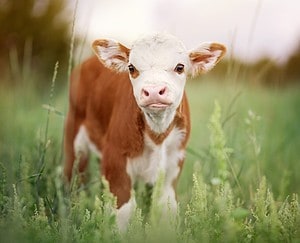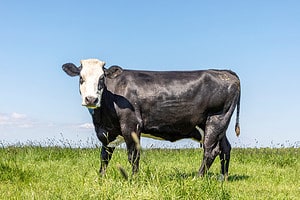A cow is a large, domesticated mammal that is typically found on farms and ranches. Cows are herbivores, meaning they subsist primarily on grasses and other vegetation. They provide us with milk, meat, leather, crop fertilizer, and more. Domesticated cows have existed since the Neolithic period (9000-4000 BCE). Today there are over 1.5 billion cows in existence across the globe! This is mostly due to the great demand for meat products in grocery stores. In the U.S. alone, the average American consumes 181 pounds of meat annually. So, what do cows drink? Keep reading to find out!
What Do Cows Drink?
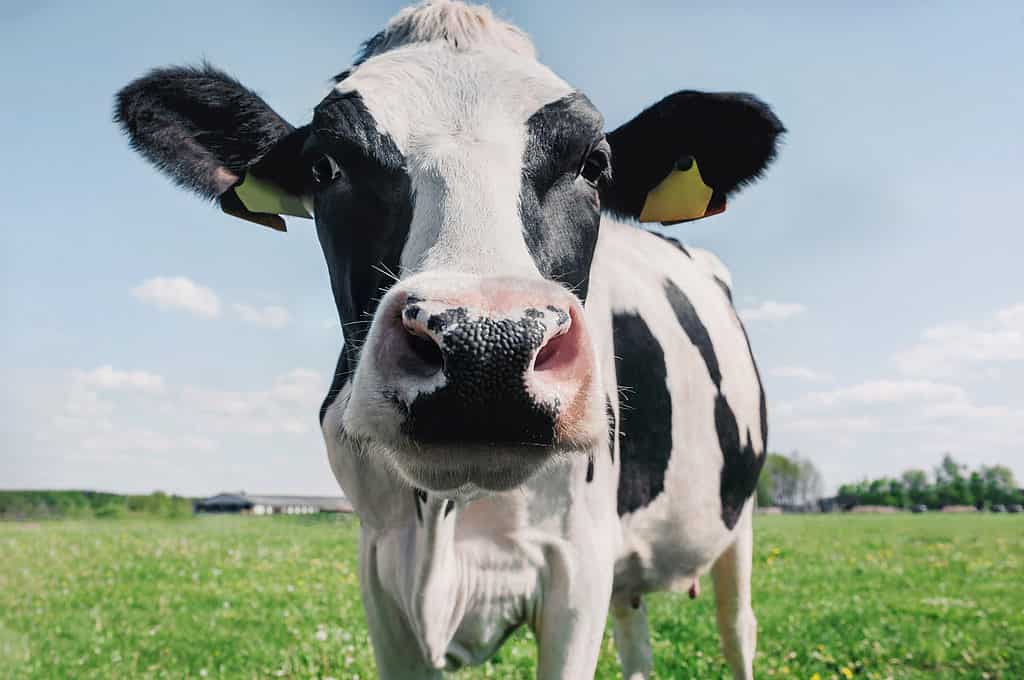
Domestic cows are curious about new things in their environment.
©Alena Demidyuk/Shutterstock.com
What Do Cows Drink? Adult cows drink water! Cows typically only drink water after they are weaned. They can also get some of their liquids from grass and hay. For example, cows that graze on pasture will naturally be able to obtain moisture from the plants they eat. Additionally, when given access to clean water sources such as troughs or ponds, cows will usually take advantage of them. On hot days, providing ample water is especially important for keeping cows healthy and comfortable. Fresh water is essential for a cow’s proper digestion and high-quality milk production.
What Do Baby Cows Drink?

Newborn calves require a critical amount of colostrum from their mother in the first few hours after birth.
©Canetti/Shutterstock.com
Baby cows, also known as calves, will typically drink their mother’s milk for the first several months of life. The timing of natural weaning is typically ten months. Some mothers nurse their calves for as long as 11.3 months. This provides them with essential nutrients and antibodies to help protect them from illness and infection.
Newborn calves require a critical amount of colostrum from their mother in the first few hours after birth. Colostrum maximizes absorption and immunity. It is ideal for the calf to quickly stand and feed from the mother. This first meal is one of the most important for the calf. During this first meal, s sequence of changes to the calf’s digestive system will occur. The intestine walls of the newborn allow for nutrients to reach the bloodstream, including colostral antibodies, as well as pathogens.
Weaning often occurs when the cow is in the later stages of pregnancy. When a cow is about to have another calf, she won’t be able to provide for both. This is when she will no longer allow the older calf to nurse. The cow will enforce this by either biting or kicking the older baby if it tries to feed. This lesson is usually quickly learned, and the calf will stay with the herd without attempting to nurse.
The nutritional needs of baby cows are not solely fulfilled by milk. As the rumen must also be developed, young calves require solid feed and water access. It is recommended that calves start eating feed within their first week. By three months, they should consume 1% of their body weight. To ensure healthy pre- and post-weaning weight gain, offer calves a tasty and accessible source of food. It’s also important to offer constant fresh water.
How Much Do They Drink?
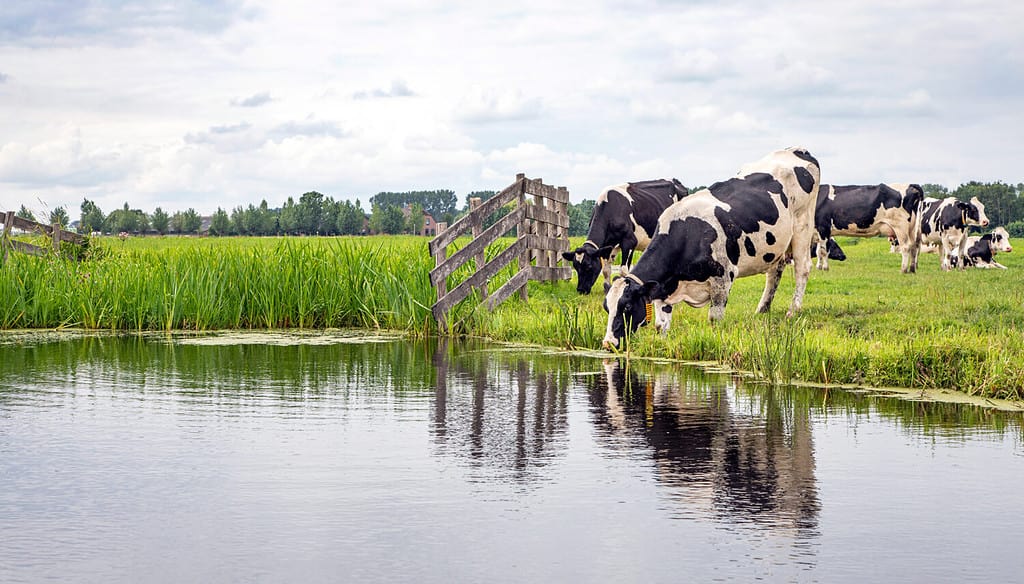
On average, cows consume one gallon of water per one hundred pounds of body weight in temperature weather.
©Clara Bastian/Shutterstock.com
Adult cows typically drink between 25 and 50 gallons of water per day. This will depend on the size and breed of the cow. In general, larger cows will consume more water than smaller breeds due to their greater metabolic demands. Additionally, lactating cows require even more water to produce milk for their calves.
To meet these needs, caregivers should ensure that there is ample access to clean drinking water year-round to maintain the cattle herd’s health. Water intake can also vary based on environmental conditions such as temperature or humidity levels. Water needs increase doubly in hot weather. On average, cows consume one gallon of water per one hundred pounds of body weight in temperature weather. When it’s hot, they need a minimum of two gallons of water for every 100 pounds of their body weight.
Digestion
Cows have a unique digestive system that is specifically adapted to eat and process grass. Their four-chambered stomach helps them break down the tough cellulose found in plant material more efficiently than other animals. The first chamber of the cow’s stomach, called the rumen, contains billions of bacteria that ferment feed and allow cows to get energy from ingested food. From there, partially digested food passes through two other chambers called the reticulum and omasum before finally entering into the fourth chamber—the abomasum—where digestion is completed with help from enzymes secreted by the pancreas and small intestine. Cows typically drink 25-50 gallons of water daily to stay hydrated and aid their digestion.
What Do They Eat?
Cows are herbivorous animals, meaning they feed on plant-based food sources. They typically graze on grasses and other vegetation types like clover, alfalfa, and forbs. In addition to these primary plants, cows will also eat hay, silage (fermented feed stored in a silo or bunker), grains such as corn or wheat bran, and even tree leaves. Depending on the region and seasonality of their area, cows may be fed different combinations of these foods.
Wild cows, or those that live in the wild rather than on a farm, and bison typically graze on grasses and other vegetation. They may also eat shrubs and small trees depending on what is available to them in their habitat. These animals are browsers, meaning they search for food at different levels of the landscape, such as standing close to the ground while grazing or reaching higher into shrubs and trees.
Behavior
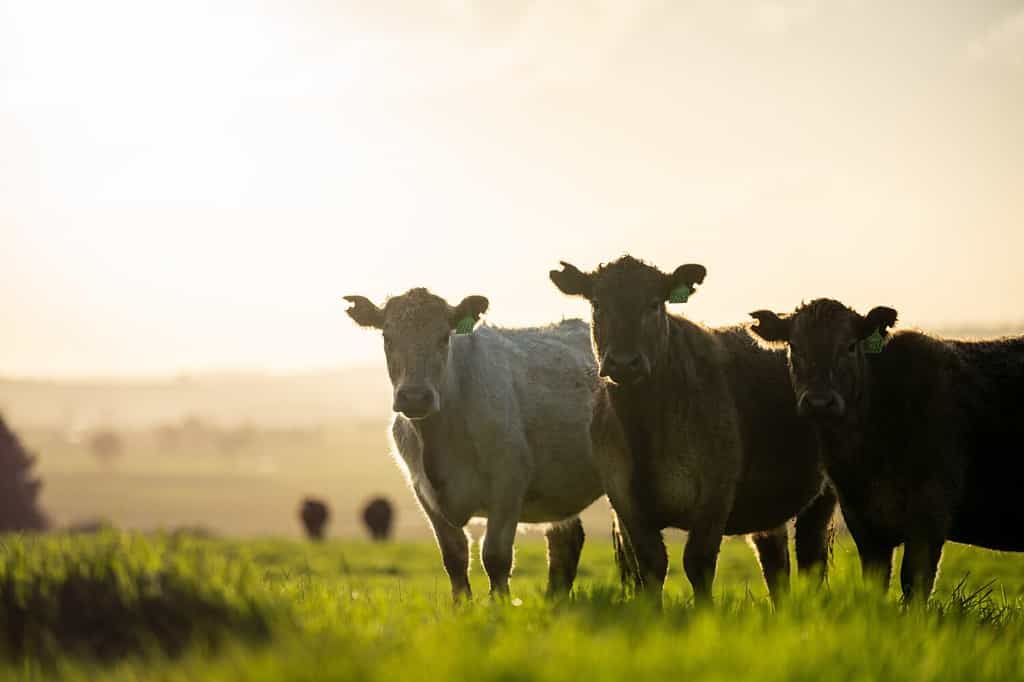
When it comes to sight, cows have color vision, which helps them detect predators from a distance as well as identify ripening fruits on trees.
©William Edge/Shutterstock.com
Cows are surprisingly intelligent animals. They possess complex cognitive abilities; their five senses (touch, taste, smell, sight, and hearing) are highly developed. Cows use their finely tuned sense of smell to recognize other cows in the herd and can even distinguish between familiar and unfamiliar ones. Their sense of taste is used to select food that is high in nutritional value for optimal health – they prefer sweeter foods like apples over bitter or sour-tasting grasses. When it comes to sight, cows have color vision, which helps them detect predators from a distance as well as identify ripening fruits on trees. Finally, regarding touch, cows enjoy being petted or scratched around their neck area by humans and have clear and obvious preferences.
Cows are able to recognize faces, show empathy towards other cows in distress, and even form strong social bonds within their herds. When it comes to decision-making, they have the ability to think abstractly and remember experiences from their past. In addition, studies suggest they experience emotions such as joy and fear just like humans do – demonstrating evidence of sentience in these animals. While more research needs to be done on cow cognition, it’s clear there is much more going on in the minds of cows than we may have initially thought!
Environmental Effect
The large water needs of domestic cattle can have a detrimental effect on the environment. As more people choose to eat beef, this creates a supply-and-demand situation. Now, more beef needs to be raised. An increase in beef production equals an increase in water usage.
According to estimates, producing only one pound of beef takes 1,847 gallons of fresh water. That is nearly 40 bathtubs full of water! In terms of comparison, all meat products have a much higher water usage than grains, beans, or vegetables. Nearly 100 percent of the water used to produce beef is used in irrigating forage and grasses for the cows to eat. Of these gallons of water, only 1.1 percent is for the cow to drink and for uses like mixing food, cleaning, etc.
Not only does this amount consume massive amounts of freshwater resources, but it also adds further stress on already limited natural resources like aquifers and rivers due to overuse and contamination from agricultural runoff. Additionally, raising cattle emits substantial amounts of greenhouse gases such as methane which contributes significantly to climate change and global warming. It is essential that we consider these environmental impacts when consuming beef or any other livestock products so that we can better protect our planet’s finite resources for future generations.
If you want to see how your lifestyle, habits, and diet create a water footprint, use this fun calculator.
The photo featured at the top of this post is © Clara Bastian/Shutterstock.com
Thank you for reading! Have some feedback for us? Contact the AZ Animals editorial team.




